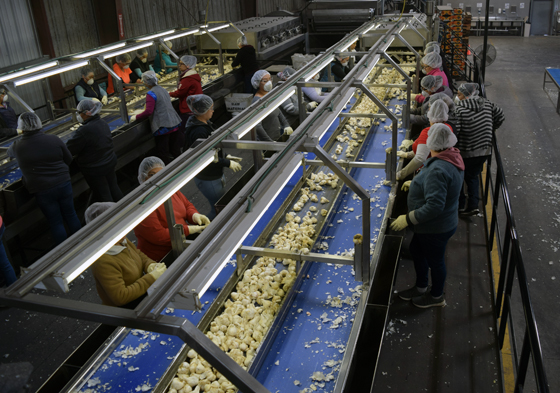
Editor’s Note: Traveling by car between San Diego and the San Francisco Bay area where their son and three grandchildren are domiciled, co-publishers Don & Nancy Harrison like to explore California’s cultural attractions.
-Third in a Series-

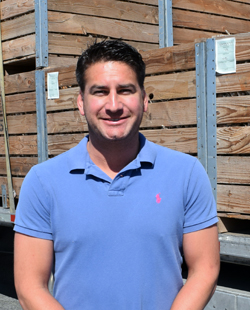
GILROY, California – With Halloween around the corner, some people’s thoughts may turn to vampires and the garlic that, according to legend, will keep them at bay. The folks here at Christopher Ranch, the largest producers of garlic in the United States, have no objection to being linked to such a spooky tradition. It’s a money-maker for them. At this time of year some of their garlic is wrapped in Halloween packaging, ready to ward off those toothy, blood-sucking invaders in any neighborhood they might appear.
Of course, that is just a tiny sliver of the garlic business that was founded in 1956 by Don Christopher, and expanded by his son Bill Christopher, who is the present CEO and director of farm operations. Grandson Ken Christopher, who studied international relations at the University of San Diego before earning an MBA at the University of San Francisco, meanwhile focuses on the financial side of the large business.
And what a business it is! From an initial ten-acre plot of garlic in 1956, the family has expanded its holdings to 6,000 acres throughout central California. Christopher Ranch harvests approximately 100 million pounds of garlic annually, which translates into the production of approximately one billion garlic bulbs every year. The company has a workforce of 1,000 permanent employees, and upwards of 2,000 employees who are brought in for the harvest season under a federal program with Mexico.
The minimum wage paid to employees is $15 per hour, and the cost of migrant workers from Mexico – once you figure in transportation, room, and board – works out to even higher, about $25 an hour, according to Ken Christopher.
An unforeseen development in the 1980s helped to propel the company into its leadership position in the industry. As Christopher tells the story, “We had some employees who were cleaning up in the packing shed and they were using compressed air to clean out some buckets. They didn’t realize that there were a handful of garlic cloves at the bottom of the bucket, so when they fired the compressed air into the bucket, the garlic whipped around and the skin fell off.
“Once my grandfather heard about what they discovered, within a matter of a year or two, he built the nation’s first industrial air compressor peeling machine – which is the ancestor of what we have today,” Christopher said. “We were first in the nation to discover that.
“From peeled garlic came chopped garlic, and crushed garlic, and garlic pesto. It opened up from just doing fresh garlic to now we have over 200 item codes that you use garlic for. Eventually peeled garlic also led to roasted garlic and that has been blowing up in popularity the last couple of decades.”
 These products, when brought to market, are certified OK kosher, Christopher pointed out.
These products, when brought to market, are certified OK kosher, Christopher pointed out.
American consumption of garlic has been growing exponentially, he added. “In the 1970’s, it was estimated that an average American maybe consumed three pounds of garlic over the course of the year. Now, due to differences in taste, differences in cuisine, as well as demographic changes, you are seeing that number triple and I would expect it to quadruple in the next few years.”
Elaborating on the changes, he said, “cuisine in general is probably a little more elaborate, a little less bland, a little more flavorful.” Today Americans are eating “more Mexican cuisine, more Italian cuisine, and more southeast Asian cuisine. Garlic has really moved from being a spice to being more of a ‘center of the plate’ item.”
Christopher said his company divides its business into four market segments. The first, accounting for approximately a third of its sales, is the retail market, including grocery stores, supermarkets, and big box stores that purchase “the smaller garlic items, such as peeled, and roasted garlic.” Next are industrial customers like Campbell Soup and Kraft Foods, which purchases 40-pound pails of peeled garlic for use in their soups. The third is the food service industry, which typically buys garlic in 5-pound bags.
“More and more,” he said, “there is a fourth category: organics. Something interesting happened this year. That market had been increasing at about 5 percent, but this year there was a 25 percent jump. So, we are scrambling to get more acreage, and more organic seed programs. Organic garlic costs more to grow so it has a higher price point, so we didn’t expect to see this giant jump, but that’s what the people want. Instead of spending 50 cents on a bulb of garlic, they will spend 80 cents, knowing that it is USDA organic certified.”
Christopher said about 10 percent of its 6,000 acres – or 600 acres – are utilized for growing organic garlic.
While some garlic is grown in Gilroy, more of it is grown in California’s great Central valley, especially in the King City area. Over time, said Christopher, it has been necessary to move the crop farther and farther north because of the changing climate, but regardless of where it is grown, it is brought to Gilroy for processing.
“Most of our fields were located south of Fresno but over the last few years, we found some issues with the crop down there. It wasn’t sizing up, and it was breaking up. Some climatic event, which for political reasons I won’t label, has begun to occur that has caused us to move our fields slowly north. So, whereas 10 years ago we were south of Fresno, now we are north of Fresno and closing in closer to the Sacramento region. We are acquiring more property in Northern California.”
He explained that garlic “thrives in a Mediterranean climate. It likes a really cold winter, and then when you come into spring, it wants a lot of heat.”
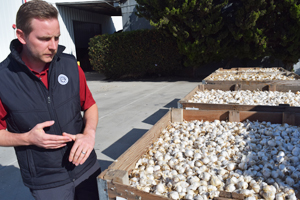
Harald Vaernes, our guide, said “Gilroy became known for garlic, a lot was grown here, because of the climate – cold evenings in the winter time, but very nice warm heat in the summer time as we approach the harvest. It takes nine months to grow garlic, only one harvest per year, so it is a lot of time, a lot of money, a lot of effort that goes into it. It is critical that we do everything according to plan and get everything right. We utilize every pound of garlic we produce.”
Taking Nancy and me around for a tour, Vaernes first pointed out wooden bins that are capable of holding a ton of garlic each. “When they come in here, we are talking about 40,000 to 50,000 bins, depending on the season.”
The bins with 2,000 pounds of garlic are dumped onto a conveyor belt which has holes through which bulbs that are too small for retail use are dropped and conveyed to a different station. Meanwhile the larger bulbs are inspected and cleaned by a production line of workers who drop them onto different belts. Those that go on a green belt will be packed into 30-pound boxes with a machine further separating them into seven different sizes. With two such production lines, “about 400,000 pounds of fresh garlic is processed every day,” Vaernes said.
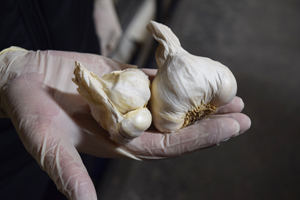
Some garlic is rejected by the workers when they see such anomalies as cloves growing on the outside of the bulb. “It’s not presentable, it’s what we call an off-grade, but the cloves are still perfect,” Vaernes said.
In the garlic business’s parlance, the smallest bulbs are called “giant;” the next largest size is “jumbo,” then “extra jumbo,” “super jumbo,” “colossal,” “super-colossal” and in a very good season, “super-super colossal,” according to Vaernes. About 360 “giant” garlic bulbs will fit into a 30-pound box, whereas only 180 of the “super-colossal” will fit. Different retailers want different sizes.
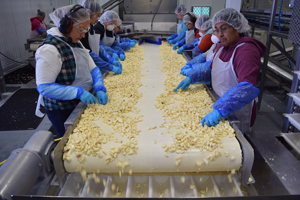
Those bulbs that don’t make it into boxes go next to another conveyor belt where they are passed under a roller that applies enough pressure to crack the bulbs into their individual components of cloves, skins, and root systems. A mechanized system removes the root plate and the loose skin. Factory workers inspect the cloves.
Thereafter the cloves go to the peeling facility where, utilizing Grandpa Christopher’s invention, “the cracked cloves are dropped into small plastic cups” and “compressed air is shot into the cup, whipping the garlic around so the skins come off.” Then an optical scanner checks if the cloves got peeled enough. If they didn’t, it will kick them out to get re-peeled.
The rest goes through an inspection belt and up an elevator for an ozonated wash, a microbial kill step, and onto another optical scanner that searches for defects. Next the batch of cloves goes into a cooler, where it spends 30 chilling minutes. Then it goes through one more scanner before it goes into an automatic packing machine.
Some cloves go to a roasting facility which recently was upgraded to process 6 million pounds of garlic a year up from 3 million.
We asked Christopher and Vaernes at separate times what are some of their favorite garlic foods. Both without hesitation mentioned “40-Clove Garlic Chicken.”
Nancy asked how long garlic normally keeps until it goes bad. They responded that if the garlic is purchased immediately after harvest, it can last up to three months, but otherwise two months. The bulbs should be kept at room temperature and not put in the refrigerator, where the humidity might cause the bulbs to start sprouting.
Although the harvest comes in only once a year, Christopher Ranch is able to sell its garlic products year round because it keeps the garlic in temperature-controlled rooms, where the temperature is close to freezing, until the bulbs are ready for preparation for market.
Every year, the City of Gilroy has a Garlic Festival at which various garlic-infused foods, including the ever-popular garlic ice cream, are sold at booths, along with such garlic themed items as T-shirts and other souvenirs. Earlier this year, a gunman, who had accessed numerous hate sites on his computer, opened fire at the festival, killing three persons and wounding 17 others before killing himself.
Christopher said the horror will not be soon forgotten and that a memorial to the victims will be carefully designed and placed. Christopher Ranch has been a leading corporate citizen of Gilroy, having contributed the land for a high school, and having built the premises, and maintaining them, for a Headstart Program on its own land.
I asked Christopher if there was a topic he’d like to cover before our interview concluded. He responded that until recently, when tariffs were imposed on imported Chinese produce, American growers faced unfair competition. He said China used to bring large quantities of garlic into the United States and then sell it at below the cost of producing it. Thirty-pound boxes that Americans needed to sell at $60, the Chinese were selling at $15, causing many cost-conscious customers to desert American growers.
While China lost money in the process, it was successful in driving out of business nine of the 12 major garlic producers in the United States, thus expanding its potential market, Christopher said. Today, there are three major garlic growers in the United States, of which Christopher Ranch is the largest.
Once the tariff was imposed, China had to sell the 30-pound boxes at $30, “which was a little bit better” and more recently, China has had to sell the boxes at $60, the same as American growers.
Christopher said American consumers should ask where the garlic comes from before buying it. If the vendor doesn’t know, he said, one way to tell is that the Chinese garlic arrives in this country with its roots completely shaved off, to meet U.S. import regulations, whereas “with California garlic, you get a nice root plate, so it is easy to tell the difference.”
*
Harrison is editor of San Diego Jewish World. He may be contacted via donald.harrison@sdjewishworld.com